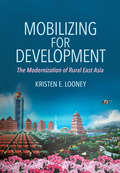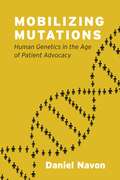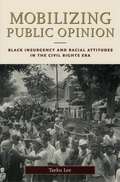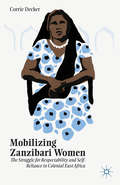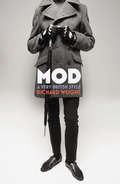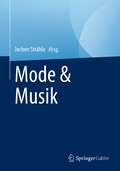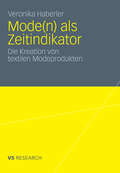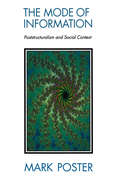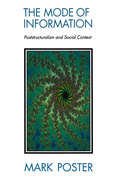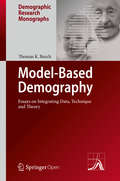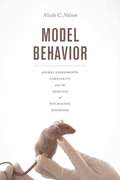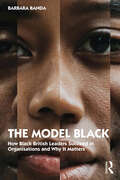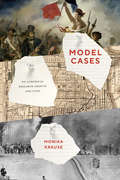- Table View
- List View
Mobilizing for Development: The Modernization of Rural East Asia
by Kristen E. LooneyMobilizing for Development tackles the question of how countries achieve rural development and offers a new way of thinking about East Asia's political economy that challenges the developmental state paradigm. Through a comparison of Taiwan (1950s–1970s), South Korea (1950s–1970s), and China (1980s–2000s), Kristen E. Looney shows that different types of development outcomes—improvements in agricultural production, rural living standards, and the village environment—were realized to different degrees, at different times, and in different ways. She argues that rural modernization campaigns, defined as policies demanding high levels of mobilization to effect dramatic change, played a central role in the region and that divergent development outcomes can be attributed to the interplay between campaigns and institutions. The analysis departs from common portrayals of the developmental state as wholly technocratic and demonstrates that rural development was not just a byproduct of industrialization. Looney's research is based on several years of fieldwork in Asia and makes a unique contribution by systematically comparing China's development experience with other countries. Relevant to political science, economic history, rural sociology, and Asian Studies, the book enriches our understanding of state-led development and agrarian change.
Mobilizing Knowledge in Healthcare: Challenges for Management and Organization
The research-practice gap is a persistent problem in healthcare - significant new knowledge is created but only some of it is shared and even less is used. As a consequence, many innovative ideas fail to change practice in healthcare settings. Academics, practitioners, and governments alike, agree that finding new ways of mobilizing knowledge is critical to reducing this gap. Yet knowledge mobilization is especially difficult in such a complex setting. This is because knowledge is essentially social and contextual in its very nature. Straightforward, linear 'transfer' models fail to work. This book provides an alternative 'knowledge mobilization' view, that examines in detail how knowledge is circulated and negotiated among those involved in healthcare, and how it is used to actually transform practice. Building on the collective scholarship of some of the most prominent academics in this area, the chapters explore the dynamics of knowledge mobilization, focusing on the challenges these pose for organization and management and how these challenges can be overcome.
Mobilizing Mutations: Human Genetics in the Age of Patient Advocacy
by Daniel NavonWith every passing year, more and more people learn that they or their young or unborn child carries a genetic mutation. But what does this mean for the way we understand a person? Today, genetic mutations are being used to diagnose novel conditions like the XYY, Fragile X, NGLY1 mutation, and 22q11.2 Deletion syndromes, carving out rich new categories of human disease and difference. Daniel Navon calls this form of categorization “genomic designation,” and in Mobilizing Mutations he shows how mutations, and the social factors that surround them, are reshaping human classification. Drawing on a wealth of fieldwork and historical material, Navon presents a sociological account of the ways genetic mutations have been mobilized and transformed in the sixty years since it became possible to see abnormal human genomes, providing a new vista onto the myriad ways contemporary genetic testing can transform people’s lives. Taking us inside these shifting worlds of research and advocacy over the last half century, Navon reveals the ways in which knowledge about genetic mutations can redefine what it means to be ill, different, and ultimately, human.
Mobilizing Mutations: Human Genetics in the Age of Patient Advocacy
by Daniel NavonWith every passing year, more and more people learn that they or their young or unborn child carries a genetic mutation. But what does this mean for the way we understand a person? Today, genetic mutations are being used to diagnose novel conditions like the XYY, Fragile X, NGLY1 mutation, and 22q11.2 Deletion syndromes, carving out rich new categories of human disease and difference. Daniel Navon calls this form of categorization “genomic designation,” and in Mobilizing Mutations he shows how mutations, and the social factors that surround them, are reshaping human classification. Drawing on a wealth of fieldwork and historical material, Navon presents a sociological account of the ways genetic mutations have been mobilized and transformed in the sixty years since it became possible to see abnormal human genomes, providing a new vista onto the myriad ways contemporary genetic testing can transform people’s lives. Taking us inside these shifting worlds of research and advocacy over the last half century, Navon reveals the ways in which knowledge about genetic mutations can redefine what it means to be ill, different, and ultimately, human.
Mobilizing Mutations: Human Genetics in the Age of Patient Advocacy
by Daniel NavonWith every passing year, more and more people learn that they or their young or unborn child carries a genetic mutation. But what does this mean for the way we understand a person? Today, genetic mutations are being used to diagnose novel conditions like the XYY, Fragile X, NGLY1 mutation, and 22q11.2 Deletion syndromes, carving out rich new categories of human disease and difference. Daniel Navon calls this form of categorization “genomic designation,” and in Mobilizing Mutations he shows how mutations, and the social factors that surround them, are reshaping human classification. Drawing on a wealth of fieldwork and historical material, Navon presents a sociological account of the ways genetic mutations have been mobilized and transformed in the sixty years since it became possible to see abnormal human genomes, providing a new vista onto the myriad ways contemporary genetic testing can transform people’s lives. Taking us inside these shifting worlds of research and advocacy over the last half century, Navon reveals the ways in which knowledge about genetic mutations can redefine what it means to be ill, different, and ultimately, human.
Mobilizing Mutations: Human Genetics in the Age of Patient Advocacy
by Daniel NavonWith every passing year, more and more people learn that they or their young or unborn child carries a genetic mutation. But what does this mean for the way we understand a person? Today, genetic mutations are being used to diagnose novel conditions like the XYY, Fragile X, NGLY1 mutation, and 22q11.2 Deletion syndromes, carving out rich new categories of human disease and difference. Daniel Navon calls this form of categorization “genomic designation,” and in Mobilizing Mutations he shows how mutations, and the social factors that surround them, are reshaping human classification. Drawing on a wealth of fieldwork and historical material, Navon presents a sociological account of the ways genetic mutations have been mobilized and transformed in the sixty years since it became possible to see abnormal human genomes, providing a new vista onto the myriad ways contemporary genetic testing can transform people’s lives. Taking us inside these shifting worlds of research and advocacy over the last half century, Navon reveals the ways in which knowledge about genetic mutations can redefine what it means to be ill, different, and ultimately, human.
Mobilizing Public Opinion: Black Insurgency and Racial Attitudes in the Civil Rights Era (Studies in Communication, Media, and Public Opinion)
by Taeku LeeWhat motivates us to change our opinions during times of political protest and social unrest? To investigate this question, Taeku Lee's smartly argued book looks to the critical struggle over the moral principles, group interests, and racial animosities that defined public support for racial policies during the civil rights movement, from the late 1940s to the mid-1960s. Challenging the conventional view that public opinion is shaped by elites, Lee crafts an alternate account of the geographic, institutional, historical, and issue-specific contexts that form our political views. He finds that grassroots organizations and local protests of ordinary people pushed demands for social change into the consciousness of the general public. From there, Lee argues, these demands entered the policy agendas of political elites. Evidence from multiple sources including survey data, media coverage, historical accounts, and presidential archives animate his argument. Ultimately, Mobilizing Public Opinion is a timely, cautionary tale about how we view public opinion and a compelling testament to the potential power of ordinary citizens.
Mobilizing Zanzibari Women: The Struggle for Respectability and Self-Reliance in Colonial East Africa
by C. DeckerThe experiences of African women in the era before independence remain a woefully understudied facet of African history. This innovative and carefully argued study thus adds tremendously to our understanding of colonial history by focusing on women's education, professionalization, and political mobilization in the East African islands of Zanzibar.
MOD: From Bebop to Britpop, Britain’s Biggest Youth Movement
by Richard WeightWelcome to the world of the sharp-suited ‘faces’. The Italianistas. The scooter-riding, all-night-dancing instigators of what became, from its myriad sources, a very British phenomenon.Mod began life as the quintessential working-class movement of a newly affluent nation – a uniquely British amalgam of American music and European fashions that mixed modern jazz with modernist design in an attempt to escape the drab conformity, snobbery and prudery of life in 1950s Britain. But what started as a popular cult became a mainstream culture, and a style became a revolution.In Mod, Richard Weight tells the story of Britain’s biggest and most influential youth cult. He charts the origins of Mod in the Soho jazz scene of the 1950s, set to the cool sounds of Charlie Parker and Miles Davis. He explores Mod’s heyday in Swinging London in the mid-60s – to a new soundtrack courtesy of the Small Faces, the Who and the Kinks. He takes us to the Mod–Rocker riots at Margate and Brighton, and into the world of fashion and design dominated by Twiggy, Mary Quant and Terence Conran. But Mod did not end in the 1960s. Richard Weight not only brings us up to the cult’s revival in the late 70s – played out against its own soundtrack of Quadrophenia and the Jam – but reveals Mod to be the DNA of British youth culture, leaving its mark on glam and Northern Soul, punk and Two Tone, Britpop and rave. This is the story of Britain’s biggest and brassiest youth movement – and of its legacy. Music, film, fashion, art, architecture and design – nothing was untouched by the eclectic, frenetic, irresistible energy of Mod.
Modality and the English Modals
by F. R. PalmerA detailed account of the many uses and functions of these verbs. The nature of modality, and some controversial issues, are also discussed.
Modality and the English Modals
by F. R. PalmerA detailed account of the many uses and functions of these verbs. The nature of modality, and some controversial issues, are also discussed.
Mode & Musik
by Jochen SträhleDieses Buch wird das Verständnis der Leser für die Verbindungen zwischen der Musik- und der Modeindustrie erweitern. Es hebt die Herausforderungen hervor, denen sich die Modeindustrie derzeit in Bezug auf den Hyperwettbewerb, die Definition immer schnellerer Trends, sich ändernde Verbraucherwünsche usw. gegenübersieht. Die Modeindustrie wird in der Tat stark von der digitalen Revolution in der Musikindustrie beeinflusst, die das Gesicht des individuellen Musikkonsums und des sozialen Bezugs verändert hat und sich daher auch auf den Modekonsum und den sozialen Bezug auswirkt. Dieses Verständnis ist von entscheidender Bedeutung, um die Strategien eines Modeunternehmens auf die Anforderungen der modernen Modekonsumenten auszurichten. Inhaltlich befasst sich das Buch zunächst mit der sozialen Perspektive von Mode und Musik. Dazu gehört eine Analyse der Musik als wichtiger Einflussfaktor für Modetrends, sowohl theoretisch als auch anhand einer Fallstudie über Grunge-Musik. Anschließend wird die Rolle der Musik in der Modebranche behandelt, wobei die Musik in den Geschäften und die Rolle der Musik in der Modekommunikation behandelt werden. Im Anschluss daran wird die Rolle der Mode im Musikgeschäft analysiert. Dazu gehören der Trend zum Co-Design von Modekollektionen, die Rolle von Musikkünstlern bei der Differenzierung nach Stilrichtungen und der Markt für Musik-Mode-Merchandise-Artikel (sowohl theoretisch als auch anhand einer Fallstudie). Abschließend werden mögliche Lehren aus der Musikindustrie für die Modeindustrie gezogen. Dazu gehört auch eine Analyse der digitalen Revolution und des Aufkommens der Crowdfunding-Idee (sowohl theoretisch als auch in einer Fallstudie).
Mode(n) als Zeitindikator: Die Kreation von textilen Modeprodukten
by Veronika HaberlerMode ist alltäglich, Mode ist vergänglich und Mode ist unsterblich. Unter Berücksichtigung der Literatur untersucht Veronika Haberler das Phänomen der Mode theoretisch und empirisch und geht der Frage nach dem Entstehungszusammenhang von textilen Moden nach. Der Prozess der Mode-Kreation wird detailliert beschrieben, die zentralen Handlungslogiken, welche die Kreation als produktives Reagieren auf Zeit deutbar machen, werden extrahiert, sowie weiterhin die spezifische historische Indexikalität von Mode besprochen. Und diese historische Indexikalität ist es auch – so das Resümee der Autorin – welche modischen Eintagsfliegen letztendlich in den Archiven der Zeit Unsterblichkeit verleiht.
The Mode of Information: Poststructuralism and Social Contexts
by Mark PosterIn this path-breaking work, Mark Poster highlights the nature of the newly emerging forms of social life, in the current era. The flexibility of language which the computer allows makes the written word less certain and less concrete. The result of these changes, Poster argues, is a new communication experience, an interaction between humankind and a new kind of reality. Poster discusses the addictive properties of television and arcade video games, as well as the surveillance possibilities which the new communication technologies offer the state. His wide-ranging analysis incorporates the new language-based theories of mathematics, philosophy and literature in Wiener, Derrida and Barthes, among others. This work is a major new contribution to the debate surrounding the future of electronically mediated-experiences.
The Mode of Information: Poststructuralism and Social Contexts
by Mark PosterIn this path-breaking work, Mark Poster highlights the nature of the newly emerging forms of social life, in the current era. The flexibility of language which the computer allows makes the written word less certain and less concrete. The result of these changes, Poster argues, is a new communication experience, an interaction between humankind and a new kind of reality. Poster discusses the addictive properties of television and arcade video games, as well as the surveillance possibilities which the new communication technologies offer the state. His wide-ranging analysis incorporates the new language-based theories of mathematics, philosophy and literature in Wiener, Derrida and Barthes, among others. This work is a major new contribution to the debate surrounding the future of electronically mediated-experiences.
Model-Based Demography: Essays on Integrating Data, Technique and Theory (Demographic Research Monographs)
by Thomas K. BurchLate in a career of more than sixty years, Thomas Burch, an internationally known social demographer, undertook a wide-ranging methodological critique of demography. This open access volume contains a selection of resulting papers, some previously unpublished, some published but not readily accessible. Rejecting the idea that demography is simply a branch of applied statistics, his work views it as an autonomous and complete scientific discipline. When viewed from the perspective of modern philosophy of science, specifically the semantic or model-based school, demography is a balanced discipline, with a rich body of techniques and data, but also with more and better theories than generally recognized. As demonstrated in this book, some demographic techniques can also be seen as theoretical models, and some substantive/behavioral models, commonly rejected as theory because of inconsistent observations, are now seen as valuable theoretical models, for example demographic transition theory. This book shows how demography can build a strong theoretical edifice on its broad and deep empirical foundation by adoption of the model-based approach to science. But the full-fruits of this approach will require demographers to make greater use of computer modeling in the statement and manipulation of theoretical ideas, as well as for numerical computation.
Model Behavior: Animal Experiments, Complexity, and the Genetics of Psychiatric Disorders
by Nicole C. NelsonMice are used as model organisms across a wide range of fields in science today—but it is far from obvious how studying a mouse in a maze can help us understand human problems like alcoholism or anxiety. How do scientists convince funders, fellow scientists, the general public, and even themselves that animal experiments are a good way of producing knowledge about the genetics of human behavior? In Model Behavior, Nicole C. Nelson takes us inside an animal behavior genetics laboratory to examine how scientists create and manage the foundational knowledge of their field. Behavior genetics is a particularly challenging field for making a clear-cut case that mouse experiments work, because researchers believe that both the phenomena they are studying and the animal models they are using are complex. These assumptions of complexity change the nature of what laboratory work produces. Whereas historical and ethnographic studies traditionally portray the laboratory as a place where scientists control, simplify, and stabilize nature in the service of producing durable facts, the laboratory that emerges from Nelson’s extensive interviews and fieldwork is a place where stable findings are always just out of reach. The ongoing work of managing precarious experimental systems means that researchers learn as much—if not more—about the impact of the environment on behavior as they do about genetics. Model Behavior offers a compelling portrait of life in a twenty-first-century laboratory, where partial, provisional answers to complex scientific questions are increasingly the norm.
Model Behavior: Animal Experiments, Complexity, and the Genetics of Psychiatric Disorders
by Nicole C. NelsonMice are used as model organisms across a wide range of fields in science today—but it is far from obvious how studying a mouse in a maze can help us understand human problems like alcoholism or anxiety. How do scientists convince funders, fellow scientists, the general public, and even themselves that animal experiments are a good way of producing knowledge about the genetics of human behavior? In Model Behavior, Nicole C. Nelson takes us inside an animal behavior genetics laboratory to examine how scientists create and manage the foundational knowledge of their field. Behavior genetics is a particularly challenging field for making a clear-cut case that mouse experiments work, because researchers believe that both the phenomena they are studying and the animal models they are using are complex. These assumptions of complexity change the nature of what laboratory work produces. Whereas historical and ethnographic studies traditionally portray the laboratory as a place where scientists control, simplify, and stabilize nature in the service of producing durable facts, the laboratory that emerges from Nelson’s extensive interviews and fieldwork is a place where stable findings are always just out of reach. The ongoing work of managing precarious experimental systems means that researchers learn as much—if not more—about the impact of the environment on behavior as they do about genetics. Model Behavior offers a compelling portrait of life in a twenty-first-century laboratory, where partial, provisional answers to complex scientific questions are increasingly the norm.
Model Behavior: Animal Experiments, Complexity, and the Genetics of Psychiatric Disorders
by Nicole C. NelsonMice are used as model organisms across a wide range of fields in science today—but it is far from obvious how studying a mouse in a maze can help us understand human problems like alcoholism or anxiety. How do scientists convince funders, fellow scientists, the general public, and even themselves that animal experiments are a good way of producing knowledge about the genetics of human behavior? In Model Behavior, Nicole C. Nelson takes us inside an animal behavior genetics laboratory to examine how scientists create and manage the foundational knowledge of their field. Behavior genetics is a particularly challenging field for making a clear-cut case that mouse experiments work, because researchers believe that both the phenomena they are studying and the animal models they are using are complex. These assumptions of complexity change the nature of what laboratory work produces. Whereas historical and ethnographic studies traditionally portray the laboratory as a place where scientists control, simplify, and stabilize nature in the service of producing durable facts, the laboratory that emerges from Nelson’s extensive interviews and fieldwork is a place where stable findings are always just out of reach. The ongoing work of managing precarious experimental systems means that researchers learn as much—if not more—about the impact of the environment on behavior as they do about genetics. Model Behavior offers a compelling portrait of life in a twenty-first-century laboratory, where partial, provisional answers to complex scientific questions are increasingly the norm.
Model Behavior: Animal Experiments, Complexity, and the Genetics of Psychiatric Disorders
by Nicole C. NelsonMice are used as model organisms across a wide range of fields in science today—but it is far from obvious how studying a mouse in a maze can help us understand human problems like alcoholism or anxiety. How do scientists convince funders, fellow scientists, the general public, and even themselves that animal experiments are a good way of producing knowledge about the genetics of human behavior? In Model Behavior, Nicole C. Nelson takes us inside an animal behavior genetics laboratory to examine how scientists create and manage the foundational knowledge of their field. Behavior genetics is a particularly challenging field for making a clear-cut case that mouse experiments work, because researchers believe that both the phenomena they are studying and the animal models they are using are complex. These assumptions of complexity change the nature of what laboratory work produces. Whereas historical and ethnographic studies traditionally portray the laboratory as a place where scientists control, simplify, and stabilize nature in the service of producing durable facts, the laboratory that emerges from Nelson’s extensive interviews and fieldwork is a place where stable findings are always just out of reach. The ongoing work of managing precarious experimental systems means that researchers learn as much—if not more—about the impact of the environment on behavior as they do about genetics. Model Behavior offers a compelling portrait of life in a twenty-first-century laboratory, where partial, provisional answers to complex scientific questions are increasingly the norm.
Model Behavior: Animal Experiments, Complexity, and the Genetics of Psychiatric Disorders
by Nicole C. NelsonMice are used as model organisms across a wide range of fields in science today—but it is far from obvious how studying a mouse in a maze can help us understand human problems like alcoholism or anxiety. How do scientists convince funders, fellow scientists, the general public, and even themselves that animal experiments are a good way of producing knowledge about the genetics of human behavior? In Model Behavior, Nicole C. Nelson takes us inside an animal behavior genetics laboratory to examine how scientists create and manage the foundational knowledge of their field. Behavior genetics is a particularly challenging field for making a clear-cut case that mouse experiments work, because researchers believe that both the phenomena they are studying and the animal models they are using are complex. These assumptions of complexity change the nature of what laboratory work produces. Whereas historical and ethnographic studies traditionally portray the laboratory as a place where scientists control, simplify, and stabilize nature in the service of producing durable facts, the laboratory that emerges from Nelson’s extensive interviews and fieldwork is a place where stable findings are always just out of reach. The ongoing work of managing precarious experimental systems means that researchers learn as much—if not more—about the impact of the environment on behavior as they do about genetics. Model Behavior offers a compelling portrait of life in a twenty-first-century laboratory, where partial, provisional answers to complex scientific questions are increasingly the norm.
Model Behavior: Animal Experiments, Complexity, and the Genetics of Psychiatric Disorders
by Nicole C. NelsonMice are used as model organisms across a wide range of fields in science today—but it is far from obvious how studying a mouse in a maze can help us understand human problems like alcoholism or anxiety. How do scientists convince funders, fellow scientists, the general public, and even themselves that animal experiments are a good way of producing knowledge about the genetics of human behavior? In Model Behavior, Nicole C. Nelson takes us inside an animal behavior genetics laboratory to examine how scientists create and manage the foundational knowledge of their field. Behavior genetics is a particularly challenging field for making a clear-cut case that mouse experiments work, because researchers believe that both the phenomena they are studying and the animal models they are using are complex. These assumptions of complexity change the nature of what laboratory work produces. Whereas historical and ethnographic studies traditionally portray the laboratory as a place where scientists control, simplify, and stabilize nature in the service of producing durable facts, the laboratory that emerges from Nelson’s extensive interviews and fieldwork is a place where stable findings are always just out of reach. The ongoing work of managing precarious experimental systems means that researchers learn as much—if not more—about the impact of the environment on behavior as they do about genetics. Model Behavior offers a compelling portrait of life in a twenty-first-century laboratory, where partial, provisional answers to complex scientific questions are increasingly the norm.
The Model Black: How Black British Leaders Succeed in Organisations and Why It Matters
by Barbara BandaThis book is for anyone who wants to understand what being more inclusive at work means, especially as it relates to black leaders. It is intended for those people who are saying “I don’t know where to start,” “I don’t know what to do” and “I don’t know what to say” when understanding and talking about race at work. Based on candid interviews with 30 successful black leaders, it peels away the multifaceted layers of black British leaders in organisations to offer a new way of thinking about the black British experience. This book provides the insights and ideas required to have positive conversations about race at work and to create work environments where black leaders can thrive. In identifying the attributes and behaviours that successful black leaders have in common, this book offers new ways of thinking about black people at work that help to further inclusion. It shines a light on the daily reality of being a black leader in the workplace, providing an alternative entry point for conversations around inclusion and explores what individuals and organisations can do to increase inclusion in the workplace. Through first-hand stories this book explores the challenges, compromises, struggles and successes that black people encounter, and the range of strategies they employ to achieve success as they navigate the “white” workplace. It is essential reading for business leaders in the private, public and third sector, human resources professionals, students, anyone teaching or mentoring black students or leaders and everyone interested in understanding race and furthering inclusion in the workplace.
The Model Black: How Black British Leaders Succeed in Organisations and Why It Matters
by Barbara BandaThis book is for anyone who wants to understand what being more inclusive at work means, especially as it relates to black leaders. It is intended for those people who are saying “I don’t know where to start,” “I don’t know what to do” and “I don’t know what to say” when understanding and talking about race at work. Based on candid interviews with 30 successful black leaders, it peels away the multifaceted layers of black British leaders in organisations to offer a new way of thinking about the black British experience. This book provides the insights and ideas required to have positive conversations about race at work and to create work environments where black leaders can thrive. In identifying the attributes and behaviours that successful black leaders have in common, this book offers new ways of thinking about black people at work that help to further inclusion. It shines a light on the daily reality of being a black leader in the workplace, providing an alternative entry point for conversations around inclusion and explores what individuals and organisations can do to increase inclusion in the workplace. Through first-hand stories this book explores the challenges, compromises, struggles and successes that black people encounter, and the range of strategies they employ to achieve success as they navigate the “white” workplace. It is essential reading for business leaders in the private, public and third sector, human resources professionals, students, anyone teaching or mentoring black students or leaders and everyone interested in understanding race and furthering inclusion in the workplace.
Model Cases: On Canonical Research Objects and Sites
by Monika KrauseIn Model Cases, Monika Krause asks about the concrete material research objects behind shared conversations about classes of objects, periods, and regions in the social sciences and humanities. It is well known that biologists focus on particular organisms, such as mice, fruit flies, or particular viruses when they study general questions about life, development, and disease. Krause shows that scholars in the social sciences and humanities also draw on some cases more than others, selecting research objects influenced by a range of ideological but also mundane factors, such as convenience, historicist ideas about development over time, schemas in the general population, and schemas particular to specific scholarly communities. Some research objects are studied repeatedly and shape our understanding of more general ideas in disproportionate ways: The French Revolution has profoundly influenced our concepts of revolution, of citizenship, and of political modernity, just like studies of doctors have set the agenda for research on the professions. Based on an extensive analysis of the role of model cases in different fields, Krause argues that they can be useful for scholarly communities if they are acknowledged and reflected as particular objects; she also highlights the importance of research strategies based on neglected research objects and neglected combinations of research objects and scholarly concerns.
